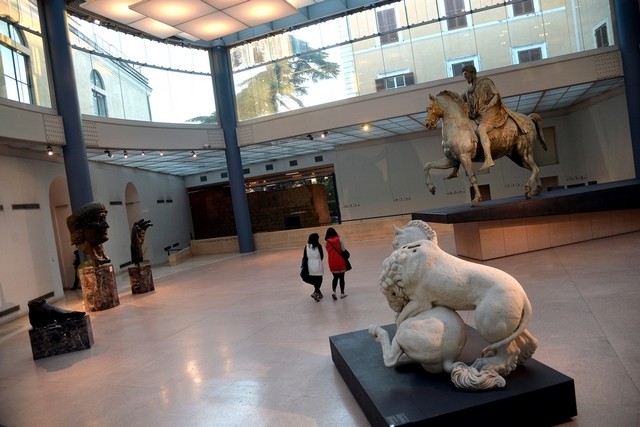
Visits to cultural attractions such as Rome’s Capitoline Museum may help fight radicalisation. Filippo Monteforte / AFP
On both sides of the Atlantic, the fight against radicalisation is evolving in unexpected ways. In the United States, a federal judge is considering whether convicted home-grown ISIL supporters can be put on a deradicalisation programme rather than clapped in jail. In Italy, the government is handing out €500 (Dh2,043) of free money to 18-year-olds to encourage cultural exploration and hopefully, a lifelong fealty to core European values that are opposed to ISIL’s iconoclasm.
Fifteen years after the September 11 attacks, the mood is changing. Counterterrorism, a ponderous field generally given over to hardline paradigms and top-secret policies, is metamorphosing into a nuanced set of soft-focus measures. It’s all very different from the hang-them-flog-them approach of the past. Both de-radicalisation and preradicalisation are being actively addressed.
The second of the two strategies, at least as pursued by the Italians, is unique. Until now, European programmes to turn individuals who might be on a path towards radicalisation have mainly involved a half-hearted form of social support and pallid cultural engagement. The UK’s Channel programme, which is part of a broader Prevent counterterrorism strategy, is a case in point. It provides counselling to youths thought to be at risk of radicalisation. But it has remained controversial among some British Muslims who see it as a police-led “gotcha” initiative rather than a sincere effort to empower families struggling to safeguard sons and daughters from the siren calls of jihadis. In Germany, deradicalisation expert Daniel Koehler has repurposed for young Muslims inspired by jihadi ideology the techniques he once used on young neo-Nazis.
But there’s never been anything like the Italian initiative. Matteo Renzi’s government began the unusual measure of bequeathing free money to 575,000 young people who turn 18 this year as a way to prevent radicalisation. The money won’t be handed over as hard cash but in the form of vouchers that allow free entry into museums and discounted access to concerts. The point, in the words of the official overseeing the initiative, is to encourage prodigious levels of youthful “cultural consumption”. The logic, he added, is that “enriching yourself as a person helps strengthen the fabric of our society”.
It is anyone’s guess if it will pay off. At just under €500 per head, it is pricey enough, leaving the Italian government stuck with a total bill of €290 million. But Mr Renzi appears to think cultural trenches are the ones to dig in the war on terrorism. After the November attacks in Paris, he said they “signalled a step-up in the cultural battle that we are living. They imagine terror, we answer with culture. They destroy statues, we love art. They destroy books, we are the country of libraries”.
Can cultural inoculation really prevent radicalisation? Will young people come away from Italy’s great temples of culture thinking exalted thoughts? Will they forget the brutal force of ISIL’s iconoclasm upon seeing Michelangelo’s sculpture David? Will notions of violent jihad be banished by a Pirandello revivalist performance? It sounds like rather a crackpot scheme but there may be some merit in trying to build a generation-spanning cultural bridge from the past, through the present, to the future. Mr Koehler, who founded the German Institute on Radicalisation and De-radicalisation Studies, describes modern radicalisation as a succession of shared “pop jihadi” offline experiences — playing basketball, listening to jihadi music, going to the mosque — that enable people to bond. Might an Italian government-funded trip to the Colosseum in Rome serve as a substitute to share instead?
But what if radicalisation has already occurred? Is it worth investing in de-radicalisation? Can it be a counterterrorism measure? The notion has its proponents, not least Mr Koehler, whose opinion will help form a Minnesota judge’s decision on the incarceration and/or rehabilitation of the Somali-Americans reportedly drawn to ISIL.
The Minnesota case is important, even if only symbolically. US district judge Michael J Davis’s unusual review of options earlier this week was the first of its kind. Perhaps it was a sign, 15 years after 9/11, that parts of the US may finally be willing to look past radicalisation and towards rehabilitation.
It is telling that the court took note of the Minnesota Somalis’ youth — they were mostly in their teens — when they conspired in 2014 to travel to the Middle East to support ISIL. And that the court said it wants to provide supervision to ensure public safety while working to help the men “become successful, law-abiding citizens”. So far, radicalised Americans have mostly received long and harsh sentences. Legal experts believe that the Minnesota sentencing could serve as a template for other judges dealing with similar cases.
The idea of reclaiming its young from the ideological stranglehold of ISIL and other extremist organisations should weigh heavily on American officials, especially after a week in which the violent radicalisation of US-bred young men has featured so prominently. Last week, Dahir Adan, a 20-year-old Somali-American in St Cloud, near Minneapolis, went on the rampage with a knife while shouting “Allahu Akbar”. And Afghan-American Ahmad Khan Rahmani was charged with bomb attacks in New York and New Jersey. Both men were born overseas but grew up in the US. Numerous other home-grown terrorism cases are pending elsewhere in the US. As they say, on such a full sea are we now afloat.
Even so, in the affairs of men, as in nature, all is ebb and tide.

